relay MITSUBISHI 380 2005 User Guide
[x] Cancel search | Manufacturer: MITSUBISHI, Model Year: 2005, Model line: 380, Model: MITSUBISHI 380 2005Pages: 1500, PDF Size: 47.87 MB
Page 129 of 1500
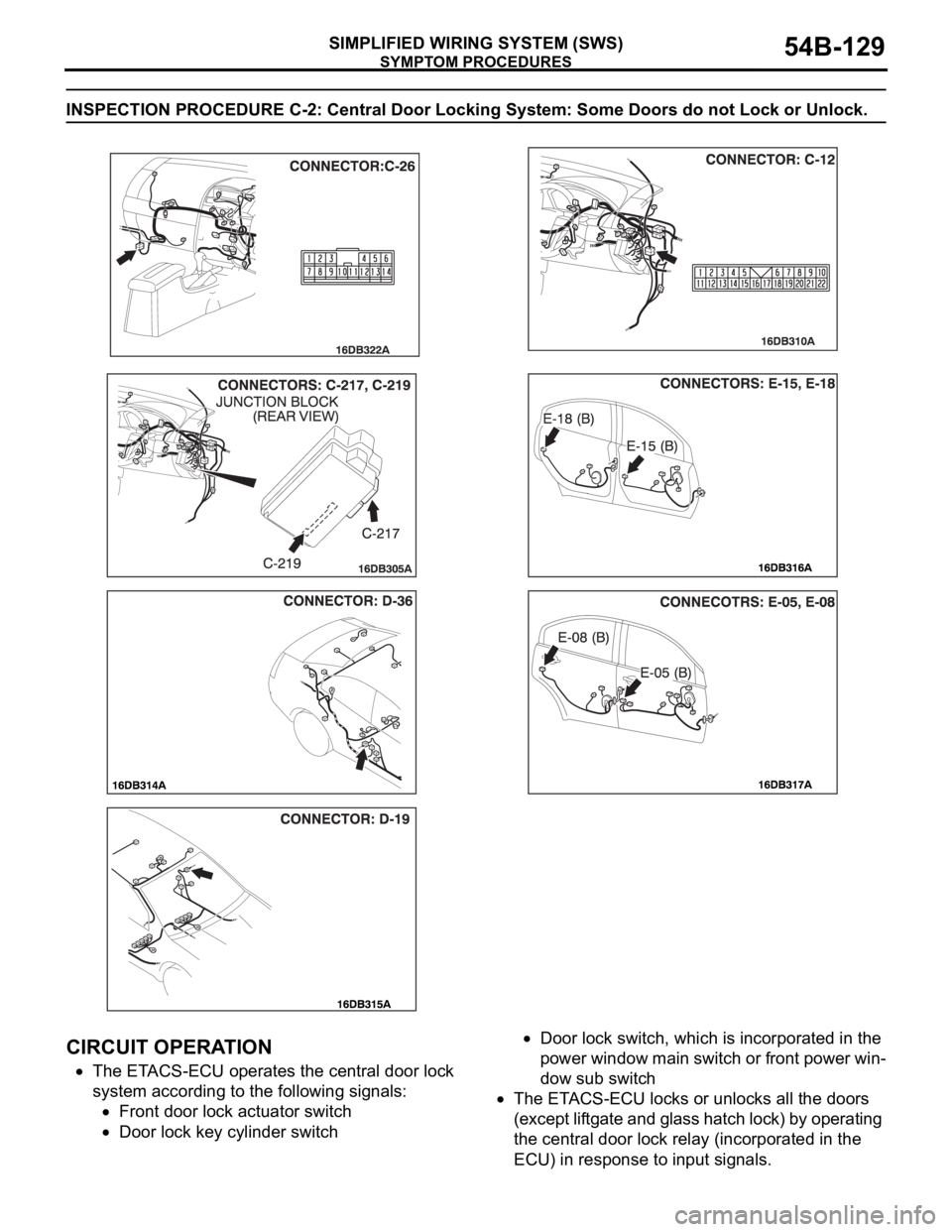
SYMPTOM PROCEDURES
SIMPLIFIED WIRING SYSTEM (SWS)54B-129
INSPECTION PROCEDURE C-2: Central Door Locking System: Some Doors do not Lock or Unlock.
.
CIRCUIT OPERATION
The ETACS-ECU operates the central door lock
system according to the following signals:
Front door lock actuator switch
Door lock key cylinder switch
Door lock switch, which is incorporated in the
power window main switch or front power win-
dow sub switch
The ETACS-ECU locks or unlocks all the doors
(except liftgate and glass hatch lock) by operating
the central door lock relay (incorporated in the
ECU) in response to input signals.
Page 150 of 1500
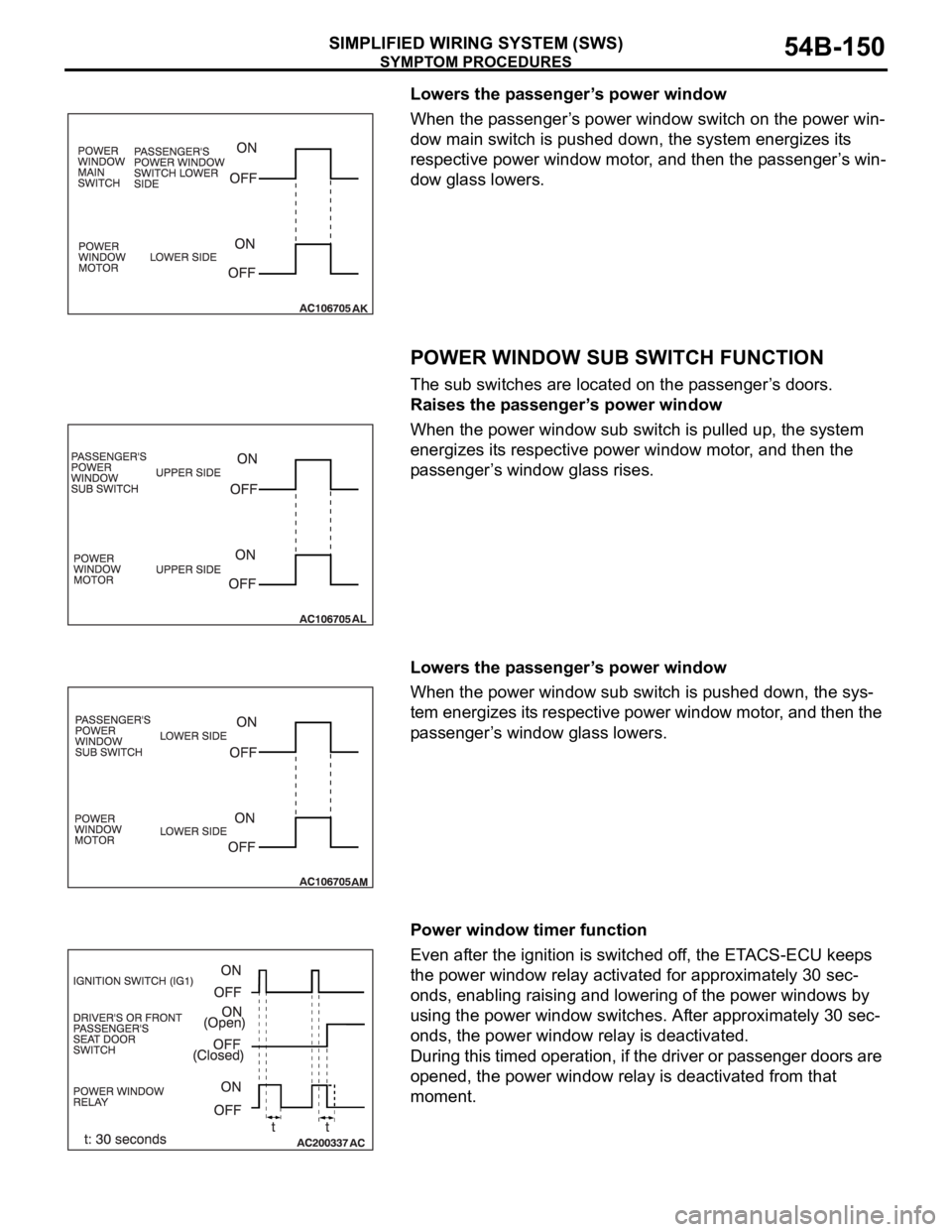
SYMPTOM PROCEDURES
SIMPLIFIED WIRING SYSTEM (SWS)54B-150
Lowers the passenger’s power window
When the passenger’s power window switch on the power win-
dow main switch is pushed down, the system energizes its
respective power window motor, and then the passenger’s win-
dow glass lowers.
POWER WINDOW SUB SWITCH FUNCTION
The sub switches are located on the passenger’s doors.
Raises the passenger’s power window
When the power window sub switch is pulled up, the system
energizes its respective power window motor, and then the
passenger’s window glass rises.
Lowers the passenger’s power window
When the power window sub switch is pushed down, the sys-
tem energizes its respective power window motor, and then the
passenger’s window glass lowers.
Power window timer function
Even after the ignition is switched off, the ETACS-ECU keeps
the power window relay activated for approximately 30 sec-
onds, enabling raising and lowering of the power windows by
using the power window switches. After approximately 30 sec-
onds, the power window relay is deactivated.
During this timed operation, if the driver or passenger doors are
opened, the power window relay is deactivated from that
moment.
Page 151 of 1500
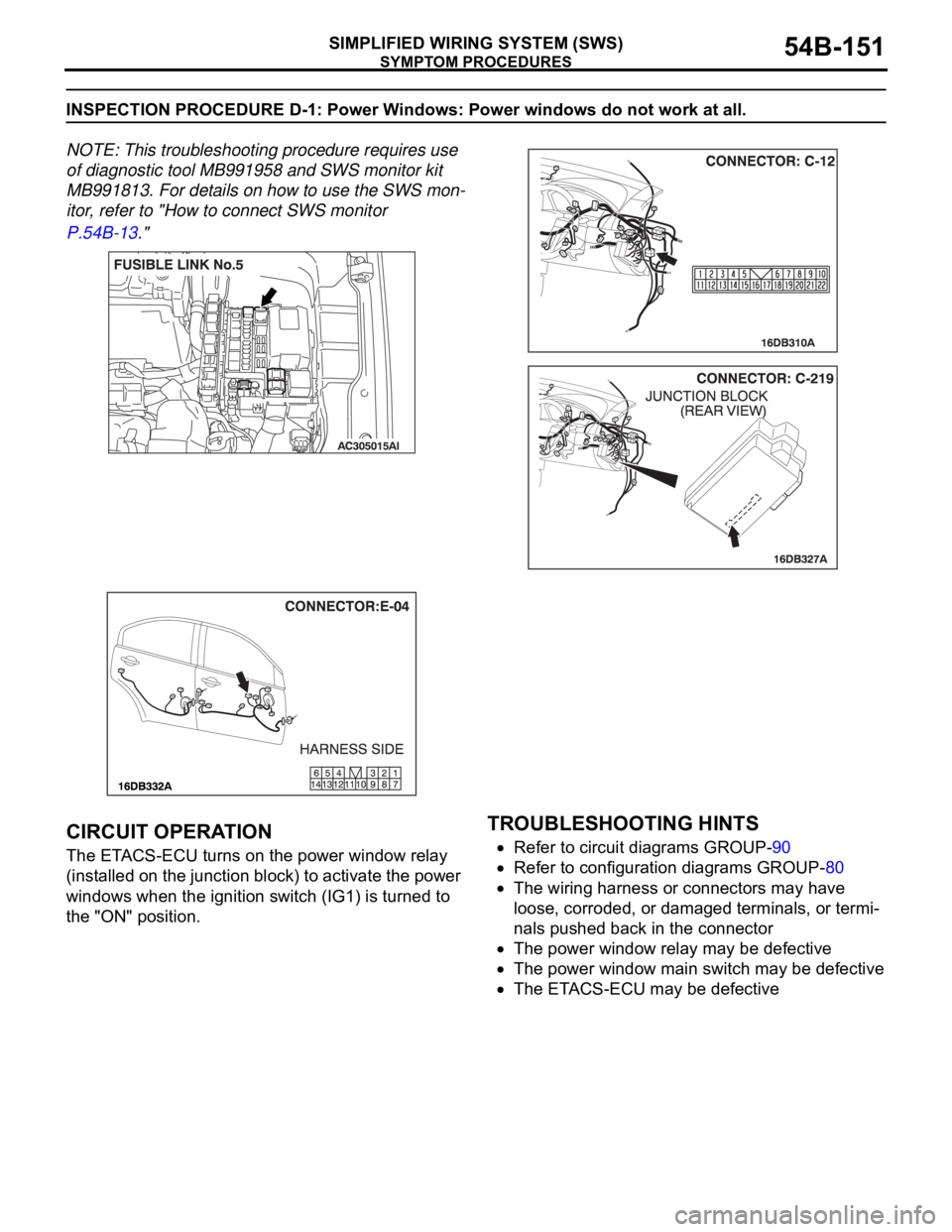
SYMPTOM PROCEDURES
SIMPLIFIED WIRING SYSTEM (SWS)54B-151
INSPECTION PROCEDURE D-1: Power Windows: Power windows do not work at all.
NOTE: This troubleshooting procedure requires use
of diagnostic tool MB991958 and SWS monitor kit
MB991813. For details on how to use the SWS mon-
itor, refer to "How to connect SWS monitor
P.54B-13."
.
CIRCUIT OPERATION
The ETACS-ECU turns on the power window relay
(installed on the junction block) to activate the power
windows when the ignition switch (IG1) is turned to
the "ON" position.
.
TROUBLESHOOTING HINTS
Refer to circuit diagrams GROUP-90
Refer to configuration diagrams GROUP-80
The wiring harness or connectors may have
loose, corroded, or damaged terminals, or termi-
nals pushed back in the connector
The power window relay may be defective
The power window main switch may be defective
The ETACS-ECU may be defective
Page 153 of 1500
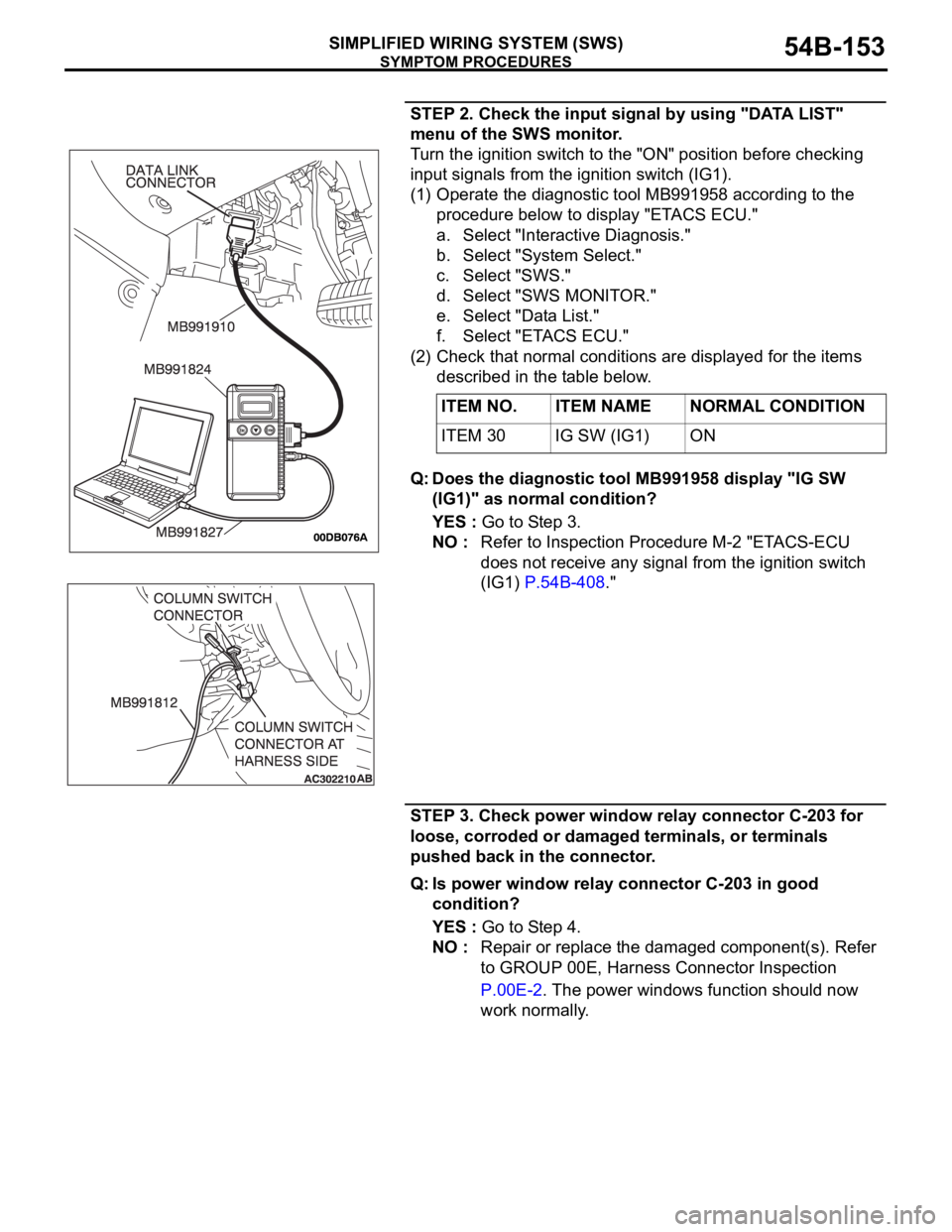
SYMPTOM PROCEDURES
SIMPLIFIED WIRING SYSTEM (SWS)54B-153
STEP 2. Check the input signal by using "DATA LIST"
menu of the SWS monitor.
Turn the ignition switch to the "ON" position before checking
input signals from the ignition switch (IG1).
(1) Operate the diagnostic tool MB991958 according to the
procedure below to display "ETACS ECU."
a. Select "Interactive Diagnosis."
b. Select "System Select."
c. Select "SWS."
d. Select "SWS MONITOR."
e. Select "Data List."
f. Select "ETACS ECU."
(2) Check that normal conditions are displayed for the items
described in the table below.
Q: Does the diagnostic tool MB991958 display "IG SW
(IG1)" as normal condition?
YES : Go to Step 3.
NO : Refer to Inspection Procedure M-2 "ETACS-ECU
does not receive any signal from the ignition switch
(IG1) P.54B-408."
STEP 3. Check power window relay connector C-203 for
loose, corroded or damaged terminals, or terminals
pushed back in the connector.
Q: Is power window relay connector C-203 in good
condition?
YES : Go to Step 4.
NO : Repair or replace the damaged component(s). Refer
to GROUP 00E, Harness Connector Inspection
P.00E-2. The power windows function should now
work normally. ITEM NO. ITEM NAME NORMAL CONDITION
ITEM 30 IG SW (IG1) ON
Page 154 of 1500
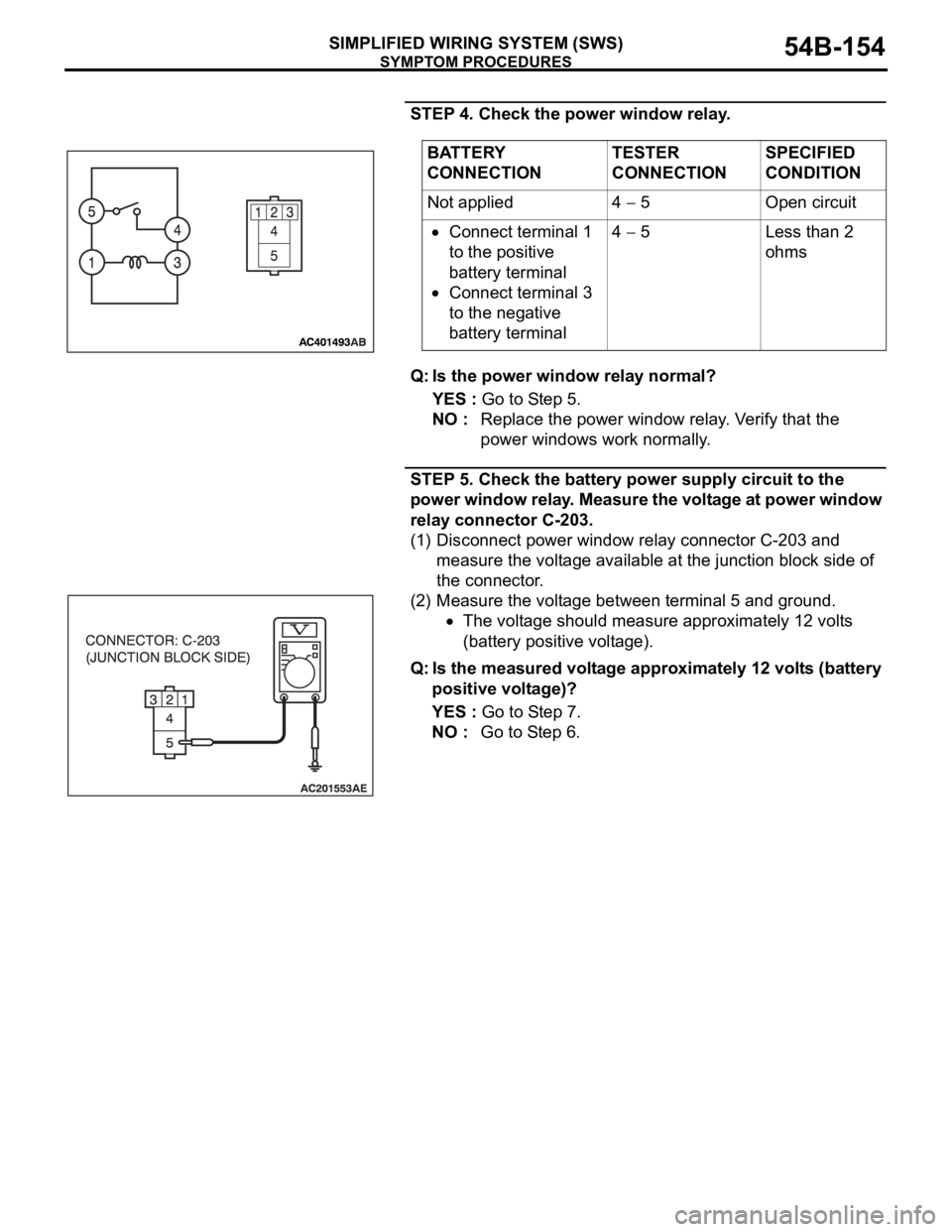
SYMPTOM PROCEDURES
SIMPLIFIED WIRING SYSTEM (SWS)54B-154
STEP 4. Check the power window relay.
Q: Is the power window relay normal?
YES : Go to Step 5.
NO : Replace the power window relay. Verify that the
power windows work normally.
STEP 5. Check the battery power supply circuit to the
power window relay. Measure the voltage at power window
relay connector C-203.
(1) Disconnect power window relay connector C-203 and
measure the voltage available at the junction block side of
the connector.
(2) Measure the voltage between terminal 5 and ground.
The voltage should measure approximately 12 volts
(battery positive voltage).
Q: Is the measured voltage approximately 12 volts (battery
positive voltage)?
YES : Go to Step 7.
NO : Go to Step 6. BATTERY
CONNECTIONTESTER
CONNECTIONSPECIFIED
CONDITION
Not applied 4
5 Open circuit
Connect terminal 1
to the positive
battery terminal
Connect terminal 3
to the negative
battery terminal4
5 Less than 2
ohms
Page 155 of 1500
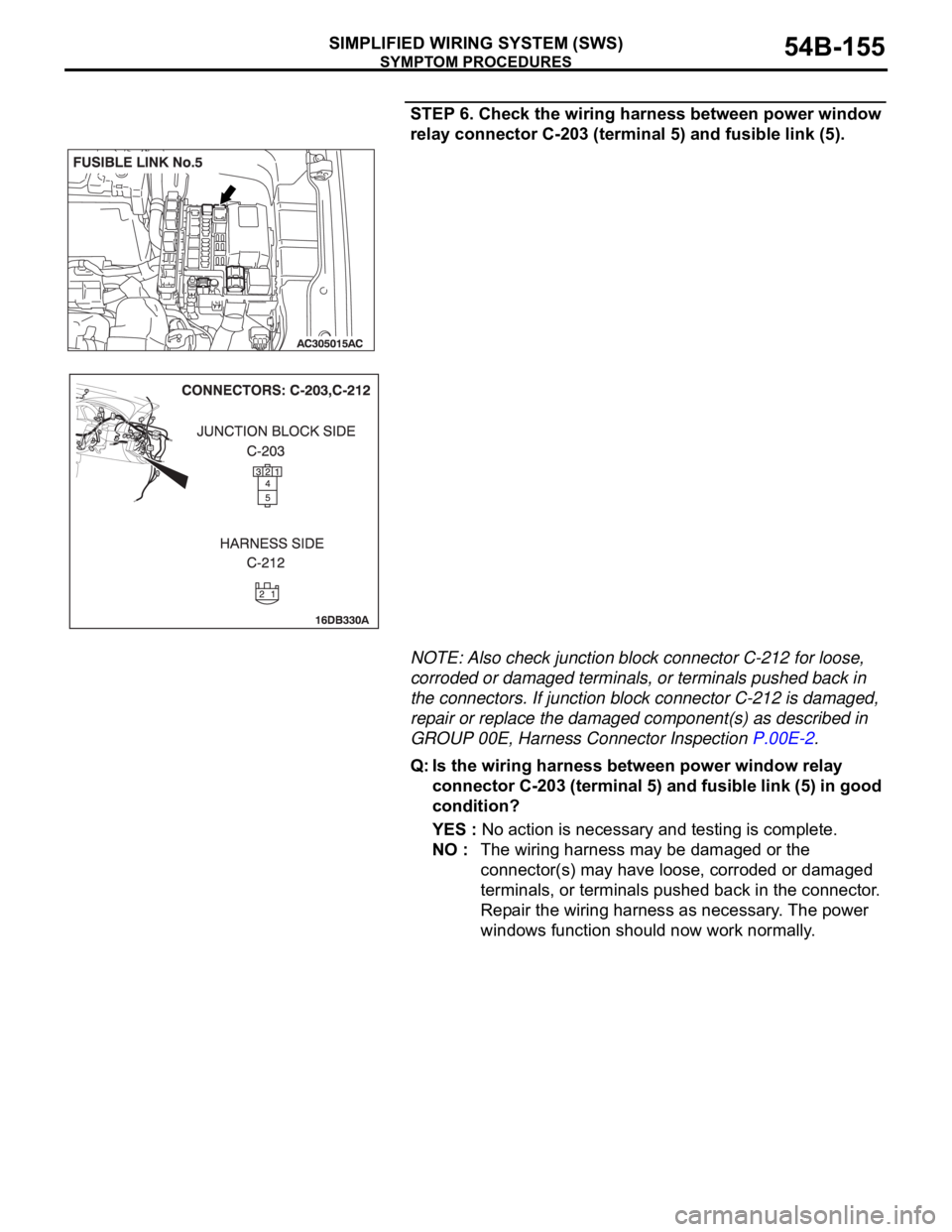
SYMPTOM PROCEDURES
SIMPLIFIED WIRING SYSTEM (SWS)54B-155
STEP 6. Check the wiring harness between power window
relay connector C-203 (terminal 5) and fusible link (5).
NOTE: Also check junction block connector C-212 for loose,
corroded or damaged terminals, or terminals pushed back in
the connectors. If junction block connector C-212 is damaged,
repair or replace the damaged component(s) as described in
GROUP 00E, Harness Connector Inspection P.00E-2.
Q: Is the wiring harness between power window relay
connector C-203 (terminal 5) and fusible link (5) in good
condition?
YES : No action is necessary and testing is complete.
NO : The wiring harness may be damaged or the
connector(s) may have loose, corroded or damaged
terminals, or terminals pushed back in the connector.
Repair the wiring harness as necessary. The power
windows function should now work normally.
Page 156 of 1500
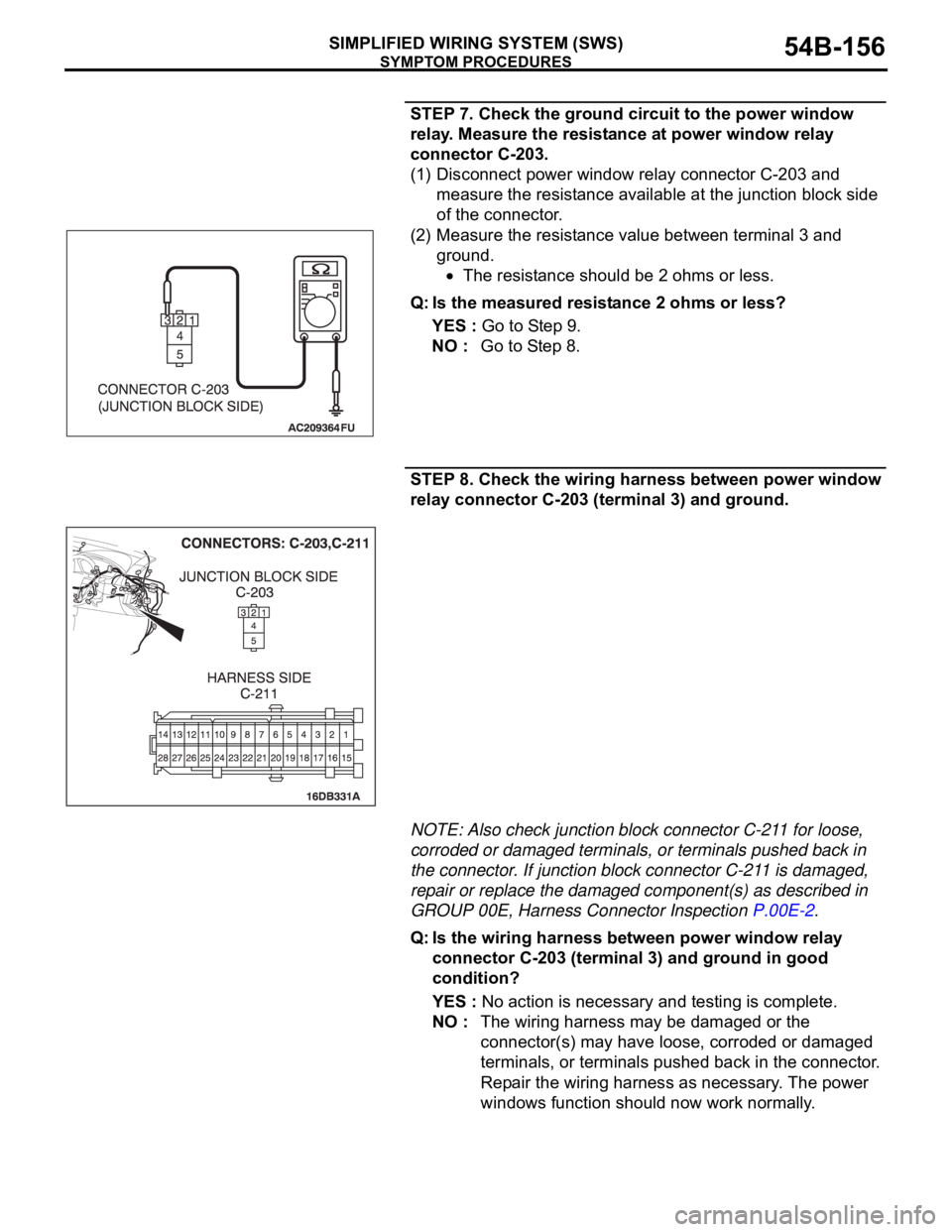
SYMPTOM PROCEDURES
SIMPLIFIED WIRING SYSTEM (SWS)54B-156
STEP 7. Check the ground circuit to the power window
relay. Measure the resistance at power window relay
connector C-203.
(1) Disconnect power window relay connector C-203 and
measure the resistance available at the junction block side
of the connector.
(2) Measure the resistance value between terminal 3 and
ground.
The resistance should be 2 ohms or less.
Q: Is the measured resistance 2 ohms or less?
YES : Go to Step 9.
NO : Go to Step 8.
STEP 8. Check the wiring harness between power window
relay connector C-203 (terminal 3) and ground.
NOTE: Also check junction block connector C-211 for loose,
corroded or damaged terminals, or terminals pushed back in
the connector. If junction block connector C-211 is damaged,
repair or replace the damaged component(s) as described in
GROUP 00E, Harness Connector Inspection P.00E-2.
Q: Is the wiring harness between power window relay
connector C-203 (terminal 3) and ground in good
condition?
YES : No action is necessary and testing is complete.
NO : The wiring harness may be damaged or the
connector(s) may have loose, corroded or damaged
terminals, or terminals pushed back in the connector.
Repair the wiring harness as necessary. The power
windows function should now work normally.
Page 160 of 1500
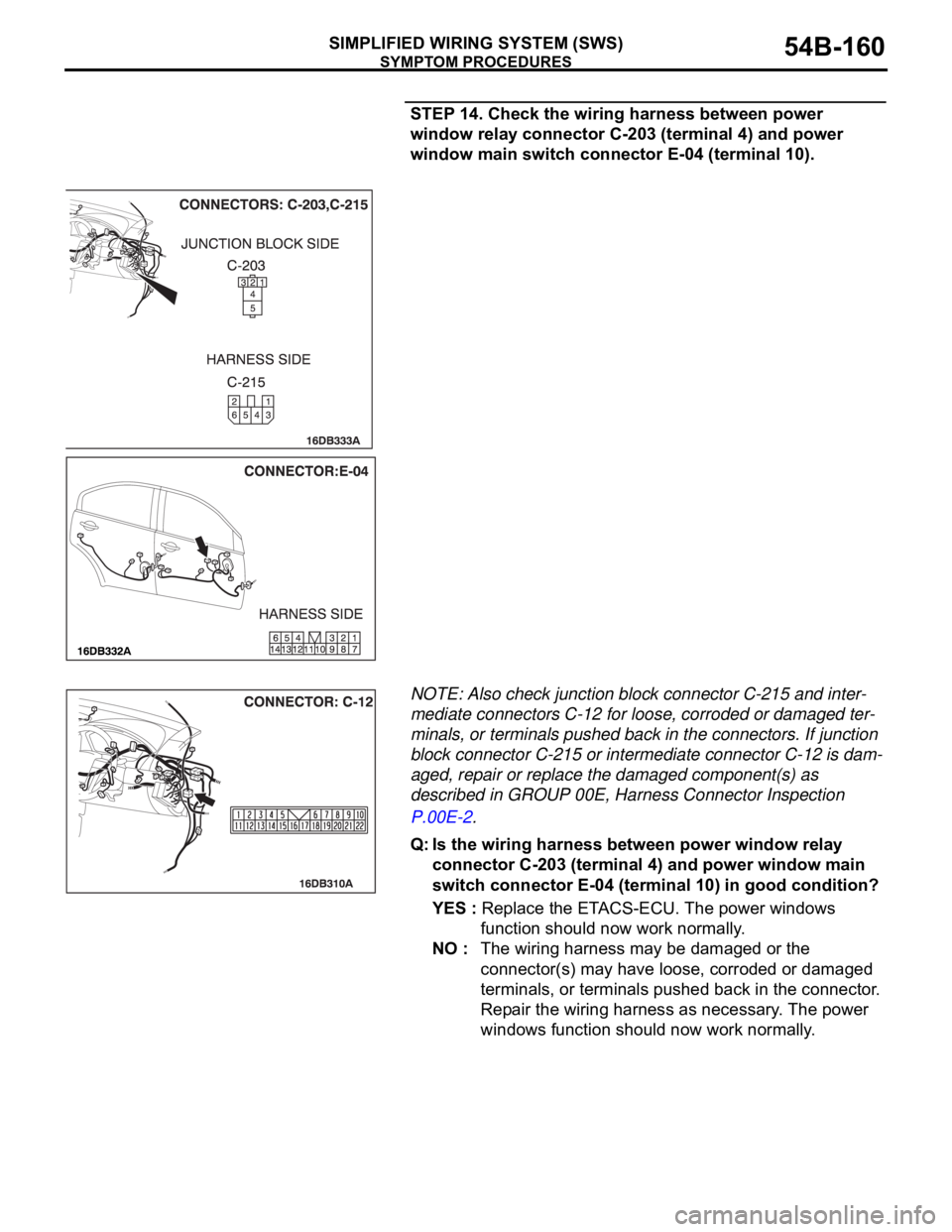
SYMPTOM PROCEDURES
SIMPLIFIED WIRING SYSTEM (SWS)54B-160
STEP 14. Check the wiring harness between power
window relay connector C-203 (terminal 4) and power
window main switch connector E-04 (terminal 10).
NOTE: Also check junction block connector C-215 and inter-
mediate connectors C-12 for loose, corroded or damaged ter-
minals, or terminals pushed back in the connectors. If junction
block connector C-215 or intermediate connector C-12 is dam-
aged, repair or replace the damaged component(s) as
described in GROUP 00E, Harness Connector Inspection
P.00E-2.
Q: Is the wiring harness between power window relay
connector C-203 (terminal 4) and power window main
switch connector E-04 (terminal 10) in good condition?
YES : Replace the ETACS-ECU. The power windows
function should now work normally.
NO : The wiring harness may be damaged or the
connector(s) may have loose, corroded or damaged
terminals, or terminals pushed back in the connector.
Repair the wiring harness as necessary. The power
windows function should now work normally.
Page 172 of 1500
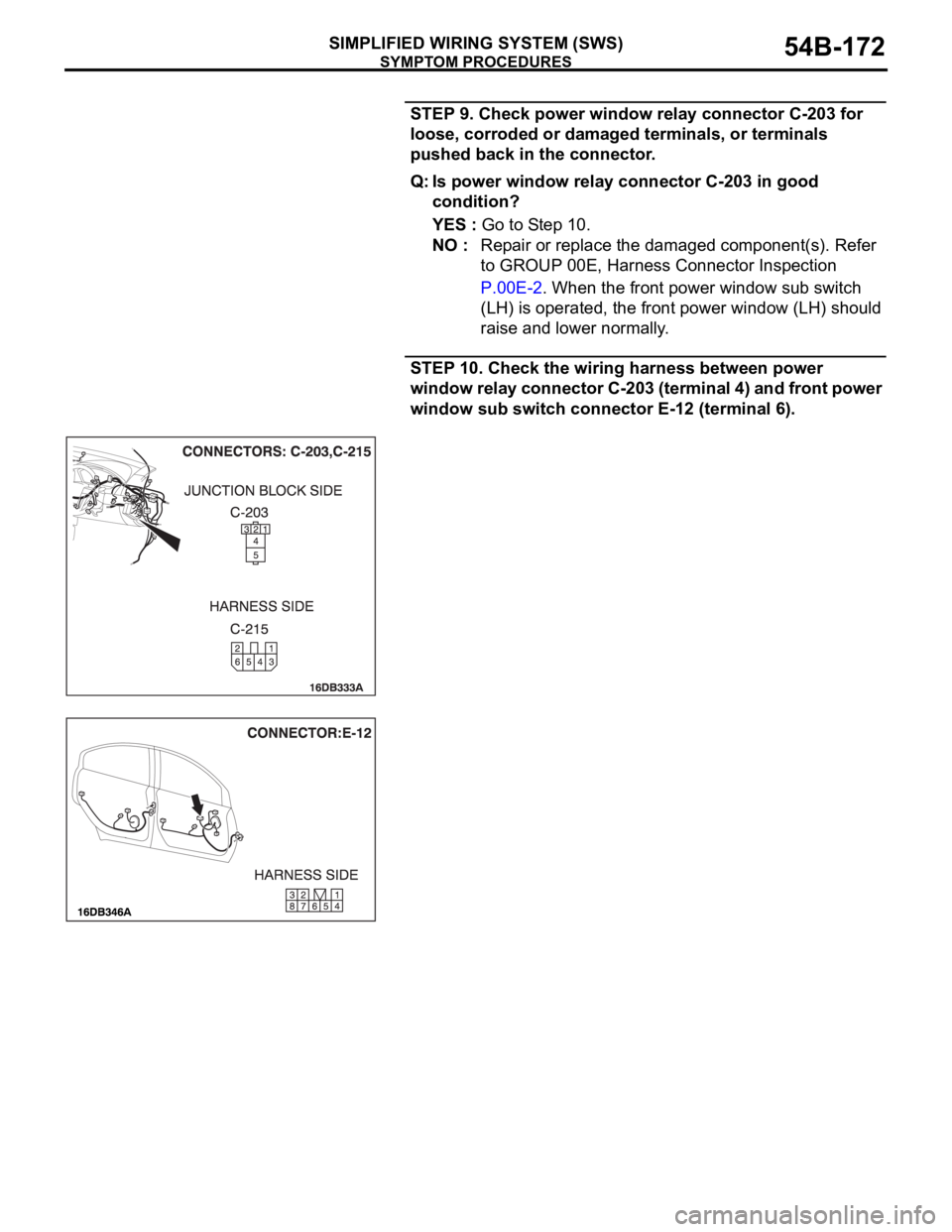
SYMPTOM PROCEDURES
SIMPLIFIED WIRING SYSTEM (SWS)54B-172
STEP 9. Check power window relay connector C-203 for
loose, corroded or damaged terminals, or terminals
pushed back in the connector.
Q: Is power window relay connector C-203 in good
condition?
YES : Go to Step 10.
NO : Repair or replace the damaged component(s). Refer
to GROUP 00E, Harness Connector Inspection
P.00E-2. When the front power window sub switch
(LH) is operated, the front power window (LH) should
raise and lower normally.
STEP 10. Check the wiring harness between power
window relay connector C-203 (terminal 4) and front power
window sub switch connector E-12 (terminal 6).
Page 173 of 1500
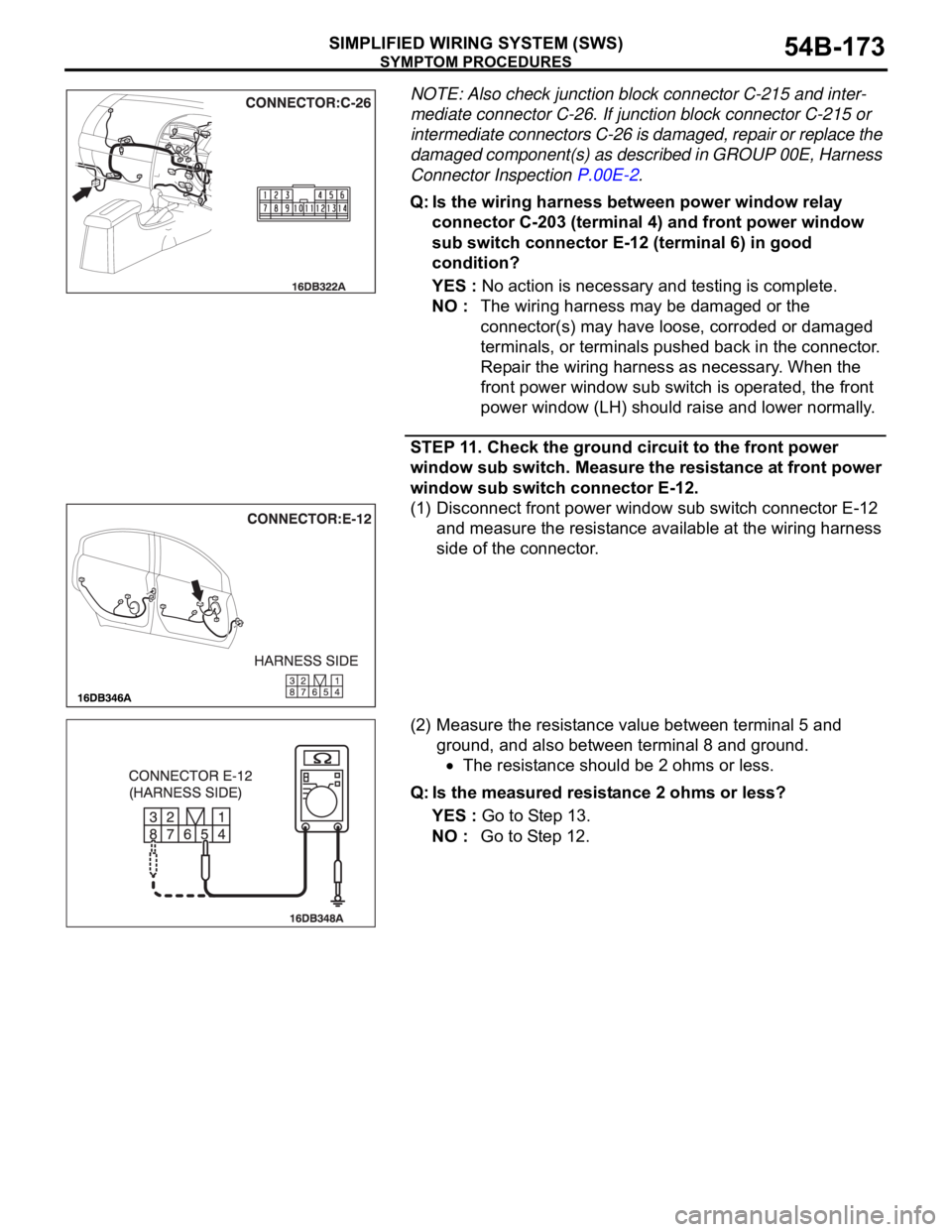
SYMPTOM PROCEDURES
SIMPLIFIED WIRING SYSTEM (SWS)54B-173
NOTE: Also check junction block connector C-215 and inter-
mediate connector C-26. If junction block connector C-215 or
intermediate connectors C-26 is damaged, repair or replace the
damaged component(s) as described in GROUP 00E, Harness
Connector Inspection P.00E-2.
Q: Is the wiring harness between power window relay
connector C-203 (terminal 4) and front power window
sub switch connector E-12 (terminal 6) in good
condition?
YES : No action is necessary and testing is complete.
NO : The wiring harness may be damaged or the
connector(s) may have loose, corroded or damaged
terminals, or terminals pushed back in the connector.
Repair the wiring harness as necessary. When the
front power window sub switch is operated, the front
power window (LH) should raise and lower normally.
STEP 11. Check the ground circuit to the front power
window sub switch. Measure the resistance at front power
window sub switch connector E-12.
(1) Disconnect front power window sub switch connector E-12
and measure the resistance available at the wiring harness
side of the connector.
(2) Measure the resistance value between terminal 5 and
ground, and also between terminal 8 and ground.
The resistance should be 2 ohms or less.
Q: Is the measured resistance 2 ohms or less?
YES : Go to Step 13.
NO : Go to Step 12.